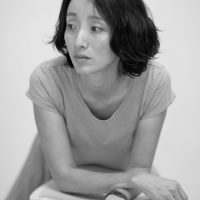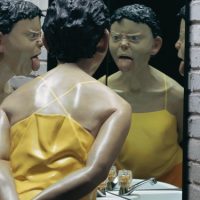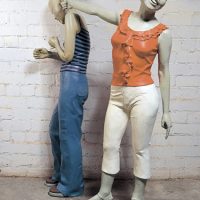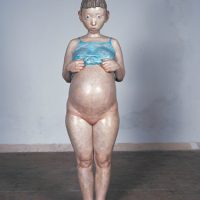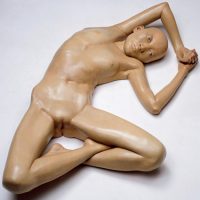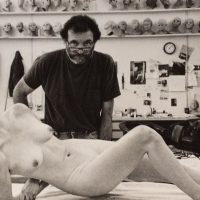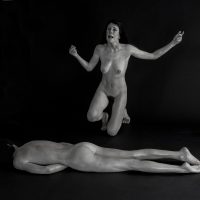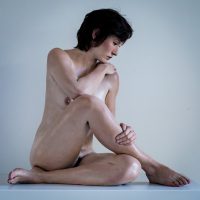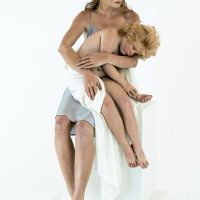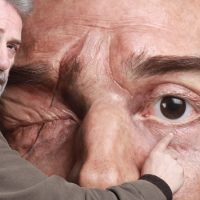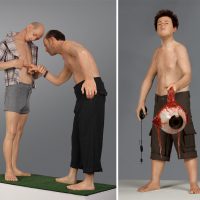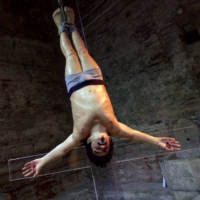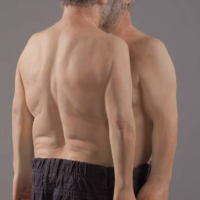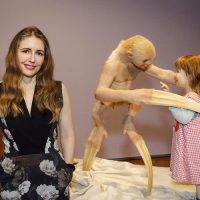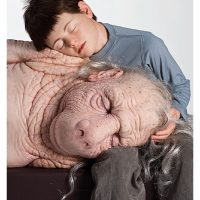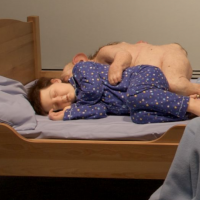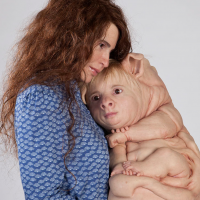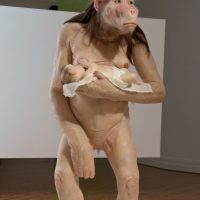This is a research on artists who focus on body and deal with plaster in their work.
Xiangjing is a Chinese female artist who mostly works in sculptures. Raised in Beijing by an editor and film director, Xiang studies at Beijing’s Central Academy of Fine Arts in 1995. She lives in an interesting period of Chinese history, the reform, the opening up, and rapid economic growth period. She often find herself unadaptable in the society. Her artworks reveals a sense of insecurity through eerily human character and life in porcelain, bronze and fiberglass. She first became famous for her women sculptures, which are often nude, slouching, and wearing vacant or depressed expressions. Her sculptures deal with everything that had to do with female existence. I like how she is dealing with human nature though gender and how she thinks that all individuals aliens, far but close to each other because all are social animals. All of her works are problem-oriented in different characters. She shapes each of her characters in to individual appearance, representing a spiritual life in this modern era. I have visited one of her show in Shanghai, and amazed by her unique style. The characters she created are so verisimilitude, giving me a feeling that they are alive. The shapes of body, the expressions of face, and the weight of fabric are finely make. The concave and the convex are smoothing connected on each part of the skin of her figures. Her figures require lots of skills and time to make. I can tell how talent she is and what kind of person she is through her work.
first row left: Xiang Jing
first row middle:
Baby Baby
Fiberglass, paint, mirror, three-cornered basin, etc.
156×85×85CM
2001
first row right:
Bang! (II)
Fiberglass and paint
162×160×110CM
2002
second row left:
Little Fruitie (II)
Fiberglass and paint
176×52×39CM
2005
second row middle:
I Am 22 Years Old, But Without My Period
Fiberglass and paint
30×155×95CM
2007
John DeAndrea is an American realistic sculptor. He was born in Denver, Colorado in 1941. After receiving his Bachelor degree from Colorado University then continued his education at University of Mexico for graduate school. His artworks are presented in some of the best art museums across America. Now, he continues to work and live in Denver, Colorado. He developed silicon casting enable him to depict precise detail such as human hair. DeAndrea uses real human hair to cast hair. He developed various technique in order to complete realistic human spirit. He has worked with fiber glass, polyvinyl resin, and bronze. DeAndrea’s earliest works were painted with automotive paint, later evolving into acrylics and then oil. In the field of photorealism, he specializes in female nudes. I like the delicacy of each work through every skin of each figures. I am trilled by the details of each characters. I can feel the emotions of each figures.
first row left: John DeAndrea Working in his Studio
first row middle: Lisa Reclining, 2015
first row right: American Icon (Kent State)
second row left: Pensive Figure, 2017
second row middle: Mother and the Child, 2013
Zarko Baseski is a Macedonian sculptor, born in 1957. He received his bachelor and mater degree at the Faculty of Fine Arts in Skopje, and later become a professor in the sculpture department. Baseski has received numerous awards and his work has been exhibited in his country and in foreign countries. He has emphasized interest in the emotional expression of the human being. Insisting on hyper realistic sculptures, creating humans with extreme lifelike appearance, he gives strong reflection of dramatic tension in his individual portrait. He is very passionate in showing human being as a symbol of ongoing existential struggle in his hyper realistic sculptures. Because of his depiction of struggle in realism, I personally dislike his works. It makes me feel uncomfortable, like I am the one struggling. In addition, the face expression on the sculptures appear unnatural to me.
first row left: Zarko Baseski
first row middle: Thomas
first row right: David
second row left: Crucifixion
second row right: Self portrait
Patricia Piccinini is originally from Freetown, Sierra Leone, later arrived in Australia. She makes sculptures of possible species by using silicone, fiberglass, even human hair, showing sculptures that appear familiar, yet hyperrealistic. Her sculptures often shows depiction of imagined human-liked creatures and their interactions with human being, giving a reminder the evolution and life on earth. In my opinion, they are crafted distinctly. Through these life-like sculptures, she asks ethical and moral questions about the role of science, medicine and technology in relation to the natural world. Trying to differentiate the natural and the artificial though her work, she always begins with drawing, which helped her to develop ideas. Using both traditional skills such as hand sculpted plasticine models as well as computer-based techniques like CNC and 3D-printing. I like how Piccinini make the nonexistence realistically, but I think it’s scary to observe. Even though her art is an exploration in science, but I think it is anti-naturalism.
first row left: Patricia Piccinini
first row middle:
The Long Awaited, 2008
Silicone, fibreglass, human hair, leather, plywood, clothing
first row right:
Undivided, 2004
Silicone, human hair, flannelette, mixed
101 x 74 x 127 cm
second row left:
The Bond, 2016
silicone, fibreglass, human hair, clothing
162cm H x 56 x 50cm
second row right:
Big Mother, 2005
Silicone, fibreglass, polyurethane, leather, human hair
175cm high
Presentation:
Chicago format research paper including bibliography:
